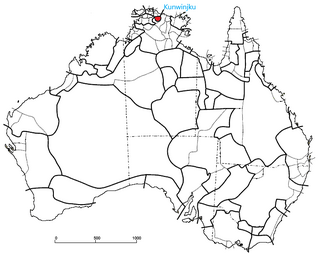The Jawoyn, also written Djauan, are an Australian Aboriginal people living in the Northern Territory of Australia. The Bagala clan are of the Jawoyn people.

Maningrida, also known as Burarran, is a small family of Australian Aboriginal languages spoken in northern Australia. It includes four languages, none closely related:
Lester Richard Hiatt, known as Les Hiatt, was a scholar of Australian Aboriginal societies who promoted Australian Aboriginal studies within both the academic world and within the wider public for almost 50 years. He is now regarded as one of Australia's foremost anthropologists.
Gurr-goni, also spelled Guragone, Gorogone, Gun-Guragone, Gunagoragone, Gungorogone, Gurrogone, Gutjertabia, is an Australian Aboriginal language spoken in Arnhem Land. There were about 60 speakers in 2011, all trilingual in Burarra or Kuninjku.
The Burarra people, also referred to as the Gidjingali, are an Aboriginal Australian people in and around Maningrida, in the heart of Arnhem Land in the Northern Territory. Opinions have differed as to whether the two names represent different tribal realities, with the Gidjingali treated as the same as, or as a subgroup of the Burarra, or as an independent tribal grouping. For the purposes of this encyclopedia, the two are registered differently, though the ethnographic materials on both may overlap with each other.

The Kunwinjku people are an Australian Aboriginal people, one of several groups within the Bininj people, who live around West Arnhem Land to the east of Darwin, Northern Territory. Kunwinjku people generally refer to themselves as "Bininj" in much the same way that Yolŋu people refer to themselves as "Yolŋu".
The Burarra language is an Australian Aboriginal language spoken by the Burarra people of Arnhem Land. It has several dialects.

The Macro-Gunwinyguan languages, also called Arnhem or Gunwinyguan, are a family of Australian Aboriginal languages spoken across eastern Arnhem Land in northern Australia. Their relationship has been demonstrated through shared morphology in their verbal inflections.
The Gunavidji people, also written Kunibidji and Kunibídji and also known as the Ndjébbana, are an Aboriginal Australian people of Arnhem Land in the Northern Territory.
The Nunggubuyu are an Aboriginal Australian people of eastern Arnhem Land in the Northern Territory.
The Murunitja are an indigenous Australian tribe of Western Australia located within the Goldfields-Esperance region.
The Gadjalivia were an indigenous Australian people of Arnhem Land in the Northern Territory. They are now regarded as extinct.
The Unjadi (Unyadi) were an indigenous Australian people of the Cape York Peninsula of northern Queensland.
The Dalabon or Dangbon are an Australian Aboriginal people of the Northern Territory.
The Banbai are an Indigenous Australian people of New South Wales.
The Yankunytjatjara people, also written Yankuntjatjarra, Jangkundjara, and other variants, are an Aboriginal Australian people of the state of South Australia.
The Antakirinja, otherwise spelt Antakarinya, and alternatively spoken of as the Ngonde, are an indigenous Australian people of South Australia.
The Wik Epa, also spelt Wikepa, are an Aboriginal Australian people, one of the Wik peoples of the Cape York Peninsula of northern Queensland.
The Yindjilandji are an indigenous Australian people of the Northern Territory.
The Yunggor were an Aboriginal Australian people of the Northern Territory.